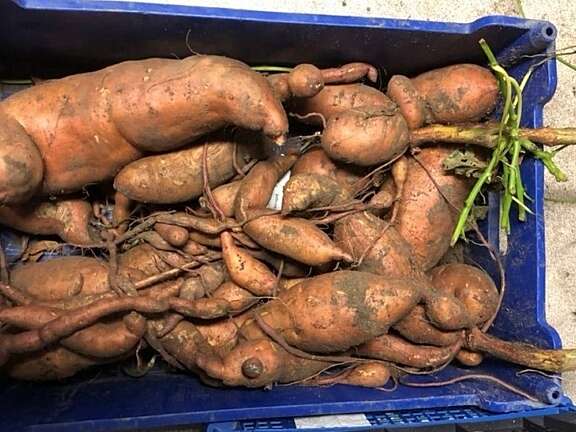
Sweet potato
| Growing calendar | |
|---|---|
| Plant out/transplant | Late May - Jun |
| Harvest | Sep |
There are two types of sweet potato. The first is the mealy-fleshed or dry type, which is usually pale in colour and tastes floury (like sweet chestnuts). The second is moist, sweeter, softer-fleshed, often orange or yellow coloured. Orange or yellow forms are high in beta carotene.
Sweet potato has a huge variety of leaf shapes and colours. Some types never flower, others blossom prolifically (outside the UK). Originating in the tropics, plants require high temperatures and a good supply of water.
Growing sweet potatoes
Sweet potato plants are not propagated by planting individual tubers - but by ‘slips’ or cuttings from the shoots, which arise from the eyes on the tuber. Several cultivars have been selected for growing in this country. Among these are ‘Beauregarde’, an orange-fleshed type and the Errato series (white, orange or purple.)
Some companies send out plug plants in the post, while others send out sweet potato slips, or unrooted cuttings, in late spring. When they arrive, carefully unpack the root cuttings and plant around the edge of a wide pot containing a mixture of equal parts of sharp sand and a loam-based compost. Keep warm, with bottom heat. Roots will soon develop, and once white shoots emerge from the base of the pot, remove and separate the plants into individual 15cm/6in pots, filled with a loam-based general-purpose peat-free compost.
Grow your own sweet potatoes by planting out the slips when the soil is warm enough. Soil temperatures need to be at least 12°C/54°F before planting out into the ground - over most of the UK, this means no earlier than late May.
Space 30-35cm (12-14in) apart, allowing slightly less distance, 25-30cm (9-12in) between plants. Bury the plants deeply, with at least half of the stems covered to encourage tuber formation. They grow reasonably well in very large containers. (Anything over 34cm/14in diameter will do, but the bigger the pot, the better the crop.)
Plants need a minimum of 22°C/68°F, and prefer 26-30°C/77-81°F, so some protection is required: polytunnel, cold greenhouse or a coldframe. Minimum survival temperature is around 6°C/45°F but even moderately cold nights will cause a severe check on growth. Fleece or plastic can be useful. The soil should be fertile but not over-rich in nitrogen, as this encourages excess foliage at the expense of tubers.
Feed growing plants regularly using comfrey liquid and water plants well in dry weather to keep them actively growing. They don’t have enough leaf to smother competitors, so weed as needed. Pinch out over-enthusiastic wandering shoots: they make a pleasant green leafy veg, briefly boiled.
Sweet potato vines can grow up to 2.1m (7ft) or more, but the plant isn’t very inclined to climb. It can be trained, if you are very strict about tying it in every couple of days. Left unattended it roots all too easily at the leaf axils so a patch can rapidly become inextricably overgrown.

Harvesting and storing sweet potatoes
Tubers will begin to form from August, but if you can, wait until the leaves have been touched by the frost before harvesting to achieve maximum yields. The tubers won’t survive frost in the soil, so lift them as soon as leaves show serious signs of cold damage. A well-grown plant can yield around 1.5-3kg of tubers in the UK.
Once lifted, rub as much soil as you can from the tubers and allow the skins to set by storing them in a warm place, around 25°C/77°F for about a week. Store the roots somewhat cooler, at the temperature of a normal living room.
Tubers easily become chilled if kept cold – store in the pantry, not the fridge - and rapidly shrivel as they dry out, so eat them fairly soon after lifting. Some people have had success with storing them like apples, in paper bags or in a single layer in trays covered with newspaper, kept in a frost and draught-free place (under the bed or the stairs) for several months.
The younger leaves are also very pleasant to eat, so any excess foliage that is trimmed off can be cooked.
| Growing notes | |
|---|---|
| Difficulty | Moderate: very weather dependent |
| Germination time | N/A |
| Average time to harvest | Approximately five months |
| Equipment needed | Heated protection to start plants off: polytunnel, coldframe or greenhouse |
| Average plant size | Varies considerably but 30cm tall and spread of up to 2m not uncommon |
| Family group | Ipomea |
| Key nutritional content | Vitamins A (in orange cultivars): B, C, calcium, iron and phosphorous. |